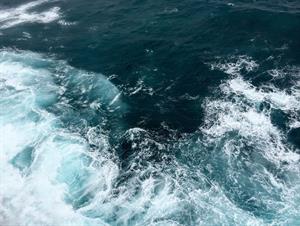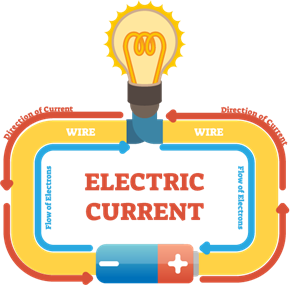
PUMPA - SMART LEARNING
எங்கள் ஆசிரியர்களுடன் 1-ஆன்-1 ஆலோசனை நேரத்தைப் பெறுங்கள். டாப்பர் ஆவதற்கு நாங்கள் பயிற்சி அளிப்போம்
Book Free DemoThe word 'current' is defined as the flow of particles in a particular direction. For example, air currents cause winds, ocean currents, etc. Likewise, electric current is the flow of electric charges in a direction.

Ocean currents
An electric current is generated by the motion of electric charges (electrons) through any conductor like copper wire. In other words, moving electrons generate an electric current.

The flow of electrons in a circuit
Have you ever noticed a river flowing through the channel or pathway while travelling on the outskirts of the city?

A river channel
When you observe a river channel, you can easily notice that the water flows from a higher level to a lower level.
Even air moves from a high-pressure region to a low-pressure region, thus creating winds. Likewise, in an electric circuit, the charges also flow in the same manner.
The direction of charges:
When a conducting path (wire) is provided to a charged object, electrons begin to flow through the path from a higher electric potential to a lower electric potential zone.

Direction of current
The direction of the current is always from the positive terminal to the negative terminal of the battery through a conducting wire.
Unit of electric current:
Electric current or simply current is denoted by the symbol 'I'. It is the total amount of charges flowing in a cross-section of a conductor in unit time.
Electric current or simply current is denoted by the symbol 'I'. It is the total amount of charges flowing in a cross-section of a conductor in unit time.

The flow of charges in a conductor
If a net charge (Q) flows through any cross-section area of a conductor in unit time (t), then the current (I) flowing through the conductor is given as,
Electric current is a scalar quantity. The SI unit of the electric current is ampere (A).
One ampere is defined as the amount of current flowing through any cross-section of a conductor when one coulomb of charge flows through it in one second.
Mathematically,
Other units in ampere:
There are some other units of ampere listed in the table below.
Units | Symbols | In ampere |
kiloampere | kA | 10^3 A |
Megaampere | MA | 10^6 A |
milliampere | mA | 10^{-3} A |
microampere | \mu A | 10^{-6} A |